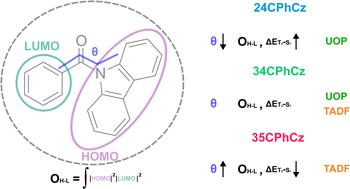当前位置:
X-MOL 学术
›
Phys. Chem. Chem. Phys.
›
论文详情
Our official English website, www.x-mol.net, welcomes your
feedback! (Note: you will need to create a separate account there.)
Competition between ultralong organic phosphorescence and thermally activated delayed fluorescence in dichloro derivatives of 9-benzoylcarbazole
Physical Chemistry Chemical Physics ( IF 2.9 ) Pub Date : 2022-11-24 , DOI: 10.1039/d2cp04802g Amir Sidat 1 , Federico J Hernández 1 , Ljiljana Stojanović 1 , Alston J Misquitta 1 , Rachel Crespo-Otero 1
Physical Chemistry Chemical Physics ( IF 2.9 ) Pub Date : 2022-11-24 , DOI: 10.1039/d2cp04802g Amir Sidat 1 , Federico J Hernández 1 , Ljiljana Stojanović 1 , Alston J Misquitta 1 , Rachel Crespo-Otero 1
Affiliation

|
Optoelectronic materials based on metal-free organic molecules represent a promising alternative to traditional inorganic devices. Significant attention has been devoted to the development of the third generation of OLEDs which are based on the temperature-activated delayed fluorescence (TADF) mechanism. In the last few years, several materials displaying ultra-long organic phosphorescence (UOP) have been designed using strategies such as crystal engineering and halogen functionalisation. Both TADF and UOP are controlled by the population of triplet states and the energy gaps between the singlet and triplet manifolds. In this paper, we explore the competition between TADF and UOP in the molecular crystals of three dichloro derivatives of 9H-carbazol-3-yl(phenyl)methanone. We investigate the excited state mechanisms in solution and the crystalline phase and address the effects of exciton transport and temperature on the rates of direct and reverse intersystem crossing under the Marcus–Levich–Jortner model. We also analyse how the presence of isomeric impurities and the stabilisation of charge transfer states affect these processes. Our simulations explain the different mechanisms observed for the three derivatives and highlight the role of intramolecular rotation and crystal packing in determining the energy gaps. This work contributes to a better understanding of the connection between chemical and crystalline structures that will enable the design of efficient materials.
中文翻译:

9-苯甲酰咔唑二氯衍生物中超长有机磷光与热激活延迟荧光的竞争
基于无金属有机分子的光电材料代表了传统无机器件的有前途的替代品。基于温度激活延迟荧光 (TADF) 机制的第三代 OLED 的开发受到了极大的关注。在过去的几年中,已经使用晶体工程和卤素功能化等策略设计了几种显示超长有机磷光 (UOP) 的材料。TADF 和 UOP 都由三重态的数量以及单重态和三重态流形之间的能隙控制。在本文中,我们探讨了 9 H的三种二氯衍生物分子晶体中 TADF 和 UOP 之间的竞争-咔唑-3-基(苯基)甲酮。我们研究了溶液和晶相中的激发态机制,并解决了激子传输和温度对 Marcus-Levich-Jortner 模型下正向和反向系统间穿越速率的影响。我们还分析了异构杂质的存在和电荷转移状态的稳定性如何影响这些过程。我们的模拟解释了观察到的三种衍生物的不同机制,并强调了分子内旋转和晶体堆积在确定能隙中的作用。这项工作有助于更好地理解化学结构和晶体结构之间的联系,从而能够设计出高效的材料。
更新日期:2022-11-24
中文翻译:

9-苯甲酰咔唑二氯衍生物中超长有机磷光与热激活延迟荧光的竞争
基于无金属有机分子的光电材料代表了传统无机器件的有前途的替代品。基于温度激活延迟荧光 (TADF) 机制的第三代 OLED 的开发受到了极大的关注。在过去的几年中,已经使用晶体工程和卤素功能化等策略设计了几种显示超长有机磷光 (UOP) 的材料。TADF 和 UOP 都由三重态的数量以及单重态和三重态流形之间的能隙控制。在本文中,我们探讨了 9 H的三种二氯衍生物分子晶体中 TADF 和 UOP 之间的竞争-咔唑-3-基(苯基)甲酮。我们研究了溶液和晶相中的激发态机制,并解决了激子传输和温度对 Marcus-Levich-Jortner 模型下正向和反向系统间穿越速率的影响。我们还分析了异构杂质的存在和电荷转移状态的稳定性如何影响这些过程。我们的模拟解释了观察到的三种衍生物的不同机制,并强调了分子内旋转和晶体堆积在确定能隙中的作用。这项工作有助于更好地理解化学结构和晶体结构之间的联系,从而能够设计出高效的材料。











































 京公网安备 11010802027423号
京公网安备 11010802027423号